Battle of Bouvines
| Battle of Bouvines | |||||||
|---|---|---|---|---|---|---|---|
| Part of the Anglo-French War (1213–14) | |||||||
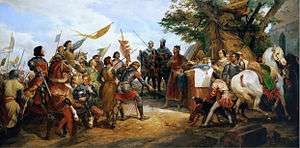 La Bataille de Bouvines, by Horace Vernet. (Galerie des Batailles, Palace of Versailles). The white Arabian horse and Moorish attendant (right) of Philippe Auguste at the Battle of Bouvines can be seen in this 1827 painting. | |||||||
| |||||||
| Belligerents | |||||||
|
|
| ||||||
| Commanders and leaders | |||||||
|
|
| ||||||
| Strength | |||||||
|
6,500–7,660[2]
|
8,800–9,000[3]
| ||||||
| Casualties and losses | |||||||
| Unknown |
169 knights killed[4] 131 knights captured[4] 400–700 Brabantine infantry killed[4] Heavy infantry casualties[5] | ||||||
The Battle of Bouvines was fought on 27 July 1214 near the town of Bouvines in the County of Flanders. It was the conclusive battle of the 1213–1214 Anglo-French War. A French army of some 7,000 men commanded by King Philip Augustus defeated an allied army of approximately 9,000 commanded by Holy Roman Emperor Otto IV.
In early 1214, a great coalition was assembled against King Philip Augustus of France, consisting of Otto IV, King John of England, Count Ferrand of Flanders, Duke Henry I of Brabant, Count William I of Holland, Duke Theobald I of Lorraine, and Duke Henry III of Limburg. Its objective was to dismember the conquests made by Philip earlier in his reign.
After initial manoeuvring in late July, battle was offered near Bouvines on 27 July. The long allied column deployed slowly into battle order, leaving the Allies at a disadvantage. The superior discipline and order of the French knights allowed them to carry out a series of devastating charges, shattering the Flemish knights on the allied left wing and capturing Count Ferrand after three hours of combat. In the centre, the allied knights and infantry under Otto enjoyed initial success, scattering the French urban infantry militia around King Philip. The Allied infantrymen nearly killed Philip. A counterattack by French knights smashed the isolated allied infantry and Otto's entire centre division fell back. Emperor Otto himself was attacked by several French knights and had to be saved by his bodyguards. Otto fled the battle and his knightly followers were defeated by the French knights, who went on to capture the Imperial eagle standard. With the Allied centre and left wing routed, only the right wing under Renaud of Boulogne and William de Longespee held on. They were killed, captured or driven from the field. A pursuit was not conducted as it was nearly dark.
The crushing French victory dashed English and Flemish hopes of regaining lost territories. Frederick II Hohenstaufen deposed the humiliated Otto as Emperor after the battle. King John was forced to agree to the Magna Carta in 1215 by his discontented barons and hand over English-occupied Anjou to Philip in a peace settlement. Counts Ferrand, Renaud and Longespee were captured and imprisoned. The balance of power in Europe shifted, with the popes of the 13th century increasingly seeking the support of a powerful France.
Prelude
In 1214, Ferdinand, Infante of Portugal, and Count of Flanders desired the return of the cities of Aire-sur-la-Lys and Saint-Omer, which he had recently lost to Philip II, King of France in the Treaty of Pont-à-Vendin. He thus broke allegiance with Philip and assembled a broad coalition including Emperor Otto IV, King John I of England, Duke Henry I of Brabant, Count William I of Holland, Duke Theobald I of Lorraine, and Duke Henry III of Limburg.[6]
The campaign was planned by John, who was the fulcrum of the alliance; his plan was to draw the French away from Paris southward towards his forces and keep them occupied, while the main army, under Emperor Otto IV, marched on Paris from the north.[6] John's plan was followed initially, but the allies in the north moved slowly. John, after two encounters with the French, retreated to Aquitaine on 3 July.
On 23 July, having summoned his vassals, Philip had an army consisting of 6,000 to 8,000 soldiers.[2] The Emperor finally succeeded in concentrating his forces at Valenciennes, although this did not include John, and in the interval Philip had counter-marched northward and regrouped.[7] Philip now took the offensive himself, and after manoeuvring to obtain good ground for his cavalry he offered battle on 27 July, on the plain east of Bouvines and the river Marque.[8] Otto was surprised by the speed of his enemy and was thought to have been caught unprepared by Philip,[lower-alpha 2] who probably deliberately lured Otto into his trap.[lower-alpha 3] Otto decided to launch an attack on what was then the French rearguard.[9]
The allied army drew up facing south-west towards Bouvines, the heavy cavalry on the wings, the infantry in one great mass in the centre, supported by a cavalry corps under Otto himself.[8] The French army formed up opposite in a similar formation, cavalry on the wings, infantry, including the town militias, in the centre. Philip, with the cavalry reserve and the royal standard, the Oriflamme, positioned himself to the rear of the men on foot.[8] It is said by William the Breton, chaplain to Philip at the battle, that the soldiers stood in line in a space of 40,000 steps (15 ha or 37 acres), which leaves very little clearance and predisposes to hand-to-hand fighting. William the Breton also says in his chronicle that "the two lines of combatants were separated by a small space".[10]
Order of battle
The evaluation of the balance of forces is controversial. Classic French historiography often refers to coalition troops as being three times more numerous than those of France. Philippe Contamine is not of this opinion: "On the face of it, his opponents did not have a clear numerical superiority".[11]
French
The French army contained 1,200–1,360 knights (of whom 765 were from the royal demesne) and 300 mounted sergeants.[12][13] Philip had launched an appeal to the municipalities in northern France, in order to obtain their support. 16 of the 39 municipalities of the royal demesne answered the call to arms. They provided 3,160 infantry, broken down as: Amiens 250, Arras 1000, Beauvais 500, Compiegne 200, Corbie 200, Bruyeres 120, Cerny and Crepy-en-Laonnais 80, Crandelain 40, Hesdin 80, Montreuil-sur-Mer 150, Noyon 150, Roye 100, Soissoins 160, and Vailly 50.[14] The balance of the infantry, possibly another 2,000 men, were composed of mercenaries.[15] The other communes of the royal demesne were supposed to provide a further 1,980 infantry, but it is doubtful that they did.[14] In total, the royal army totalled approximately 6,000–7,000 men.
The royal army was divided into three parts, or "battles":
- The right wing, composed of the knights of Champagne and Burgundy, was commanded by the Duke of Burgundy Eudes and his lieutenants: Gaucher of Châtillon Count of Saint-Pol, Count Wilhelm I of Sancerre, Count of Beaumont and Mathieu of Montmorency and Adam II Viscount of Melun.[16] In the front of the right wing were men-at-arms and militia from Burgundy, Champagne, and Picardy led by 150 mounted sergeants from Soissons.[14][17]
- The central battle was led by Philip Augustus and his chief knights – William des Barres, Bartholomew of Roye, Girard Scophe known as "Girard the Sow",[lower-alpha 4] William of Garland, Enguerrand of Coucy and Gautier of Nemours. In front of the king and his 175 knights were 2,150 infantry from the towns of the Île de France and Normandy.[18][2][17]
- The left wing was led by Robert of Dreux, supported by Count William of Ponthieu. The main body of the left wing consisted of Bretons and militia from Dreux, Perche, Ponthieu, and Vimeux.[17]
The bridge of Bouvines, the only means of retreat across the marshes, was guarded by 150 sergeants-at-arms, who also formed the French reserve.
Allied
Otto's army contained some 1,300–1,500 knights: 600–650 Flemish, 425–500 Hainaulter and 275–350 from elsewhere. He also fielded approximately 7,500 infantry, to give a total force of just under 9,000 men. The imperial army was also formed up in three battles:
- The left flank, under the command of Ferrand of Flanders with his Flemish knights – directed by Arnaud of Oudenaarde. The infantry were from Flanders and Hainaut.[19]
- The centre was under the command of Otto and of Theobald, Duke of Lorraine, Henry, Duke of Brabant, and Philip Courtenay, Marquis of Namur. It included many Saxons and infantry from Brabant and Germany. In the front of the battle stood German pike phalanxes. Saxon infantry formed the second line. Otto stood between these with 50 German knights.[17]
- The right flank, under the command of Renaud de Dammartin, included Brabant infantry and English knights, the latter under the command of the Earl of Salisbury William Longespée.[17]
On the extreme right, English archers supported the flank of both the Brabant infantry and the nobles of the two Lorraines.[20]
Battle
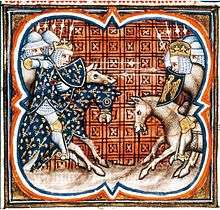
Allied left
The battle opened with an attack by 150 light cavalrymen from the Abbey of Saint-Médard de Soissons against the Flemish knights on the allied left, aiming to throw it into confusion.[21] The Flemish knights easily drove off the unarmoured horsemen.[21] Some Flemish knights left their formations and chased the retreating light cavalry.[21] 180 French knights from Champagne in turn attacked and killed or captured the over-aggressive Flemish knights.[16][21] The Count of Flanders counter-attacked with his entire force of 600 knights and threw the French back.[22][21]
Gaucher de Châtillon launched his 30 knights at the Flemish, followed by a further 250 knights.[16][21] They carried out a series of continuous charges against the Flems, and halted the allied advance.[21] Many knights on both sides fell from their horses in the first clash.[23] The French were better ordered than the more loosely formed Flemish knights, and the allied ranks grew thinner as they were assaulted by the compact French masses.[23] Châtillon and Melun with their knights broke through the ranks of their Flemish counterparts, then wheeled and struck them from the rear, constantly switching targets.[23] St. Pol's knights and the Burgundians engaged in an exhausting struggle against the Flemish, taking no prisoners.[23] The Duke of Burgundy's horse was killed and the Duke thrown to the ground, but he was saved by his knights, who beat off the Flemish and found him a fresh horse.[23]
The Flemish fought on for three hours despite their increasingly desperate situation, driven by knightly honour.[23] Finally, the wounded and unhorsed Count of Flanders was captured by two French knights, triggering the collapse of Flemish morale.[23][24]
Centre
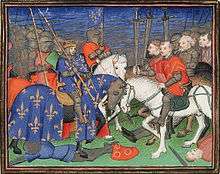
The French urban militia infantry, 2,150 strong, were gathered under the Oriflamme in the centre, in front of Philip's knights and the fleur-de-lis standard.[14][23] Soon after deploying, they were attacked by allied knights and infantry under Otto and thrown back.[23] Otto and his knights had nearly reached the French king when they were halted by French knights.[25] The allied infantrymen broke through to Philip and his handful of knightly companions, unhorsing him with their hooked pikes.[26] The French king's armour deflected an enemy lance and saved his life.[26] Gales de Montigny used the royal standard to signal for help and another knight gave Philip a fresh horse.[26]
The allied infantry used daggers to stab unhorsed French knights through the eye-slits in their enclosed helmets or great helms and other weak spots in their armour.[26] The Norman knight Etienne de Longchamp was killed in this way and the French suffered heavy losses.[26] After repeated French counterattacks and a prolonged fight the allies were thrown back.[26][8]
The battle in the centre was now a melee between the two mounted reserves led by the King and the Emperor in person. The French knight Pierre Mauvoisin nearly captured Otto and his horse and Gérard la Truie stabbed the Emperor with a dagger, which bounced off his coat of mail and struck Otto's horse in the eye, killing it.[26] Otto was saved by four German lords and their followers.[26][8] As the French sent more knights to attack him personally he fled the field.[26] The German knights fought to the bitter end to save their emperor, all being killed or captured.[26] The Imperial Standard with the eagle and dragon was captured by the French knights, who brought it to their king.[26] By this time, Allied resistance in the centre had ceased.[26]
Allied right
Meanwhile, on the French left Robert de Dreux's troops were at first pressed by men led by William Longespée.[27] William Longespée was unhorsed and taken prisoner by Philip of Dreux, the Bishop of Beauvais, and the English soldiers fled. Mathieu de Montmorency captured twelve enemy banners. (In memory of this feat, the shield of Montmorency includes an additional twelve eagles or sixteen altogether instead of the previous four.)[28]
Last stand
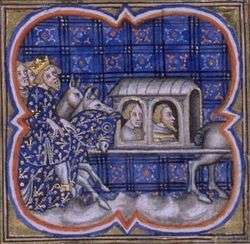
The day was already decided in favour of the French when their wings began to close inwards to cut off the retreat of the imperial centre.[26] The battle closed with the celebrated stand of Reginald of Boulogne (Renaud de Dammartin), a former vassal of King Philip, who formed a ring of 400–700 Brabant pikemen. They defied every attack by the French cavalry, while Reginald made repeated sorties with his small force of knights.[27] Eventually, long after the Imperial army had retreated, the Brabant schiltrom was overrun by a charge of 50 knights and 1,000–2,000 infantry under Thomas de St Valery.[4] Reginald was taken prisoner in the melee.[4]
The prisoners from the battle also included two other counts, Hainaut Ferrand and William Longespée, twenty-five barons and over a hundred knights.[4] The death toll amounted to about 170 knights from the allied army, and many thousands of foot soldiers on either side.[8] A pursuit was not conducted owing to the approaching nightfall and a fear that the prisoners might escape. The French formations were recalled using trumpets.[4]
Aftermath
According to Jean Favier Bouvines is "one of the most decisive and symbolic battles in the history of France".[29] For Philippe Contamine "the battle of Bouvines had both important consequences and a great impact".[30] Ferdinand Lot called it a "medieval Austerlitz".
Philip returned to Paris triumphant, marching his captive prisoners behind him in a long procession, as his subjects lined the streets to greet the victorious king. In the aftermath of the battle, Otto retreated to his castle of Harzburg and was soon overthrown as Holy Roman Emperor by Frederick II, who had already been recognised as emperor in the south a year and a half earlier.[31] Count Ferdinand remained imprisoned following his defeat, while King John obtained a five-year truce, on very lenient terms given the circumstances.[32]
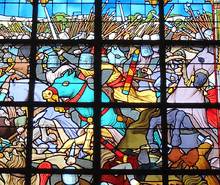
Philip's decisive victory was crucial to the political situation in England. The battle ended all hope of a restoration of the Angevin Empire.[33] So weakened was the defeated King John that he soon needed to submit to his barons' demands and agree to the Magna Carta, limiting the power of the crown and establishing the basis for common law.[34]
Commemoration
In thanksgiving for the victory, Philip Augustus founded the Abbey of Notre Dame de la Victoire, between Senlis and Mont l'Evêque.[35] In 1914, to mark the seventh centenary, Félix Dehau had the parish church of Bouvines rebuilt with a number of stained-glass windows representing the history of the battle.[36] In 2014, the eighth centenary was commemorated in Bouvines by an association called Bouvines 2014. A series of events, including an official ceremony and a show called "Bouvines la Bataille" attracted more than 6,000 viewers in Bouvines.[37]
References
Notes
- ↑ 600–650 Flemish, 425–500 Hainaulter, 275–350 for the rest
- ↑ The chroniclers say that Otto also strongly expressed his surprise to find himself facing the French army, while he believed they were on the run. Bouvines.com
- ↑ This is the hypothesis of the rhyming chronicles by Philippe Mousket: "At the approach of night, gathered the council, between him and his barons, For the good king, with his armies (around 21,555) wanted to go to Mortagne. But those of his followers knew not how to advise him. When everyone had said his piece, with the best of intentions, (v.21560) Girard the Sow spoke : "Sire, will you not go there; Truly, there are difficulties and harshness, and there are also three large villages and two small rivers beyond (v.21565) that prevent us passing to reach this place. But if you return towards your land, and the Flemings, who want war, if you turn back, will say that you flee, (v.21570) And when you follow this path with pride, with confidence, without any order, as all of us want to be Sire, and you, without crown or anger. Command a good rearguard, (v.21575) So that they are never separated. And also save your battles, and keep your soldiers close to their arms as a ruse. They will be ready if they are attacked. (v.21580) When you see the Flemings coming, they will be at your convenience." Everything was well accepted, and nothing more was discussed. they all went to sleep, (v.21585) And when the day came, the king drew up his battle, and made his orders to the troops. The carting and pack animals left the front during this time. (v.21590) "
- ↑ Girard Scophe was called the Sow, due to the Latin equivalent of his name: scrofa.
Citations
- ↑ The government of Philip Augustus: foundations of French Royal power in the Middle Ages. University of California Press. 1986. p. 381. ISBN 978-0-520-07391-3. Retrieved 28 April 2013.
- 1 2 3 Verbruggen 1997, pp. 245–246.
- ↑ Verbruggen 1997, pp. 246–247.
- 1 2 3 4 5 6 7 Verbruggen 1997, p. 255.
- ↑ Verbruggen 1997, pp. 253–255.
- 1 2 Verbruggen 1997, p. 239.
- ↑ Verbruggen 1997, p. 240.
- 1 2 3 4 5 6

- Charles Oman, History of the Art of War, vii. pp. 457–480
- Kõhler, Kriegsgechichte, &c., i. 140
- Delpech, Tactique au XIIIe siècle, 127.
- ↑ Verbruggen 1997, p. 241.
- ↑ La Philippide de Guillaume le Breton
- ↑ "The opinion of Philippe Contamine". Archived from the original on 14 February 2012. Retrieved 17 May 2012.
- ↑ J. Bradbury, Philip Augustus: King of France 1180–1223, 283
- ↑ Verbruggen 1997, pp. 244–245.
- 1 2 3 4 Verbruggen 1997, p. 245.
- ↑ Armies of Feudal Europe 1066–1300, p. 10
- 1 2 3 Verbruggen 1997, p. 242.
- 1 2 3 4 5 Verbruggen 1997, p. 250.
- ↑ Verbruggen 1997, p. 243.
- ↑ Verbruggen 1997, p. 249.
- ↑ i.e. Duchy of Lorraine and County of Bar
- 1 2 3 4 5 6 7 Verbruggen 1997, p. 251.
- ↑ Verbruggen 1997, p. 246.
- 1 2 3 4 5 6 7 8 9 Verbruggen 1997, p. 252.
- ↑ Devries, Kelly, Martin Dougherty, Ian Dickie, Phyllis G. Jestice, and Christer Jorgensen. Battles of the Medieval World: 1000–1500. New York: Barnes & Noble, 2006. p. 80-89.
- ↑ Verbruggen 1997, pp. 252–253.
- 1 2 3 4 5 6 7 8 9 10 11 12 13 Verbruggen 1997, p. 253.
- 1 2 Verbruggen 1997, p. 254.
- ↑ Gabriel Eysenbach, History of Heraldry and the Science of Coats-of-Arms, 1848, p. 321 (Fr)
- ↑ Dictionnaire de la France médiévale, Paris, Fayard, 1993, p. 176
- ↑ Histoire militaire de la France (tome 1, des origines à 1715), Paris, PUF, 1992, p. 83
- ↑ Kamp, N. "FEDERICO II di Svevia, imperatore, re di Sicilia e di Gerusalemme, re dei Romani". Dizionario Biografico degli Italiani. Enciclopedia Italiana. Archived from the original on 26 March 2012. Retrieved 7 May 2011.
- ↑ Gillingham, John (1984). The Angevin Empire. London: Hodder Arnold. p. 106. ISBN 978-0340741153.
- ↑ Sumption 1990, p. 355.
- ↑ France, John (2015). "The Battle of Bouvines 27 July 1214". In Halfond, Gregory I. The Medieval Way of War: Studies in Medieval Military History in Honor of Bernard S. Bachrach. Farnham: Ashgate Publishing, Ltd. pp. 251–253. ISBN 978-1-4724-1958-3.
- ↑ Auguste Morel, De Paris à Cologne, à Bruxelles, à Senlis, à Laon... itinéraire descriptif et historique Archived 5 March 2016 at the Wayback Machine., Libr. de L. Hachette et Cie., 1864, p. 280
- ↑ Association Bouvines 2014 Le 700e anniversaire en 1914 Archived 14 June 2016 at the Wayback Machine.
- ↑ Bouvines la Bataille Son et lumière Archived 14 June 2016 at the Wayback Machine.
Bibliography
- Georges Duby, The Legend of Bouvines (1990).
- Sumption, Jonathan (1990). Trial by Battle. London: Faber and Faber. ISBN 978-0571200955.
- Verbruggen, J.F. (1997) [1954]. The Art of Warfare in Western Europe During the Middle Ages: From the Eighth Century to 1340 [De Krijgskunst in West-Europa in de Middeleeuwen, IXe tot begin XIVe eeuw]. Translated by Willard, S. (2nd ed.). Suffolk: Boydell Press. ISBN 0 85115 630 4.